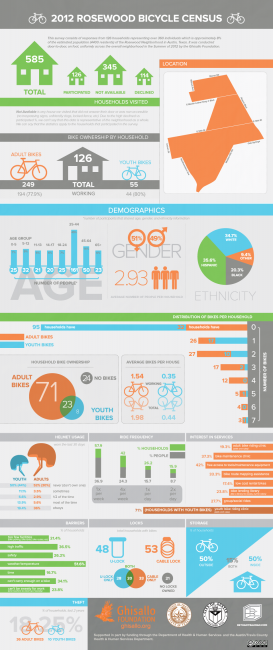Since 2011, the Ghisallo Cycling Initiative has been growing its programs and services offered within Austin. Many of these focus on East Austin communities involving Martin Middle School and the Boys and Girls Club East Campus, as well as pop-up events such as Bike Rodeos and Bike Valets for events like Cinema East. To help develop a deeper understanding of this community’s overall bicycle ownership, usage, needs and interests, we approached the City of Austin’s Health and Human Services Department and were awarded a mini-grant to help us gather information to provide a useful snapshot of the Rosewood Neighborhood.
With the funding in place and an initial survey compiled, we approached a number of graduate students and professors at the University of Texas Health and Science Center to review our survey for structural issues, question format, and reliability. They were able to provide valuable comments and suggestions which resulted in a well structured and targeted survey, and we would like to thank Charles Shumate, Kimberlty Wilson, Xiaofen Keating, Eileen Nehme, Elizabeth Korinek, Meredith Hodgkinson, and others for helping us edit and fine tune the survey’s questions.
There are an estimated 4,400 individuals living within the Rosewood Neighborhood (1.033 sq miles). The overall goal was to directly survey households and gather survey responses representing, at a minimum, 354 or 8% of the residents. Although only a sample of the targeted population will be surveyed, it should provide a representative sample and enable current problems and barriers to bicycling – in terms of journey-to-work trips, local errand trips, and recreational trips – to be defined and future solutions and/or policies to be developed. The Rosewood Neighborhood is a perfect target neighborhood due in part to it being in central east Austin making it a highly bike-able region which also contains a Capital Metro MetroRail station, an available City of Austin Parks & Recreation activity center with associated pool, is adjacent to an Austin Community College campus, being racially diverse, containing one to two public housing complexes, and containing a higher-than-average percentage of below poverty line (relative to Austin as a whole) households. Lower-income households typically own older automobiles which are higher polluting in addition to being more at risk for lifestyle-based health issues (obesity, diabetes, etc). These two issues make lower-income households perfect candidates for policy implementations which would assist in the addition of bicycles to a household’s transportation and lifestyle (activity) choices.
The survey was grouped into a four main sections: Bike Usage Profile (ownership, ride frequency, helmet use, trip distances, etc), Bike Equipment and Storage Profile (ownership of tools, locks, etc as well as how the bicycle is stored when not in use), Bicycle Interest (in riding in general, and in specific services or clinics), and Household Profile (demographics). Households without any bike ownership were included in the survey because we wanted a general view of the neighborhood as a whole, and not owning a bicycle does not imply lack of interest in owning or riding a bicycle. A specific barrier may be in play, and removal of that barrier may enable the individual to incorporate bicycling into their lifestyle either for recreation or transportation.
At the conclusion of the survey we had met most but not all of our goals. We hit our target number of individuals (a bit over 8% at 360-370 residents) but we had a high number of households who declined to participate relative to those that did participate (114 declined vs 126 participated). What that means for us is we can’t really make blanket statements about the Rosewood Neighborhood because we can’t know why the 114 declined (no bike ownership so no interest in participating vs don’t like taking surveys vs were busy and didn’t want to take the time). Although we did not get as broad of a set of data as we had hoped due to the decline rate, we did compile a very diverse cross section of the neighborhood, which may be weighted towards cyclists in general, but also includes approximately 20% of its data from households which own zero bicycles. The data also provides detailed insight into youth ownership and ridership where youth is defined as 13 years old or younger. This age bracketing was determined more by the level of bicycle the youth rider would most likely be using rather than being the legal definition of youth (under 18 years old). Once someone has reached High School, they are probably riding what would be considered an adult level bicycle. This decision does mean that the helmet use statistics are not fully representative of all under 18 year old riders who are, by law, required to wear a helmet while riding in Austin. That said, helmet usage programs typically target Elementary and Middle School level students (3-13 years old) rather than High School (14-18 years old), and the rate of “Never” wear a helmet is consistent across both youth and adult riders, but possibly for different reasons.
The final infographic which was developed, in partnership with Bethany Bauman, can be viewed below. It is released under the Creative Commons Attribution-NonCommercial-ShareAlike 3.0 License so feel free to redistribute it or create your own non-commercial derivative works, but you will need to keep the original attributions and share your work under the same license. We collected more data than we could distill into the final overview infographic and those additional data points may be released in another format in the future. We also hope to duplicate this effort in another Austin neighborhood in the future, possibly the Allandale Neighborhood.

